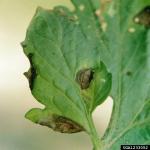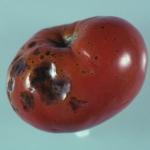Solanaceous, Early Blight
Alternaria solani
Early blight caused by the fungus Alternaria solani occurs wherever potatoes and tomatoes are grown. Uncontrolled, the disease may cause serious defoliation, resulting in decreased yield and quality.
Identification:
Early blight occurs on the foliage, stem, and fruit of tomato. It first appears as small brown to black lesions on older foliage. The tissue surrounding the initial lesion may become yellow, and when lesions are numerous entire leaves may become chlorotic. As the lesions enlarge, they often develop concentric rings giving them a ‘bull’s eye’ or ‘target-spot’ appearance. In the late summer when conditions are favorable for disease development, lesions can become numerous and plants defoliated, reducing both fruit quantity and quality. Fruit can become infected either in the green or ripe stage through the stem attachment. Lesions can become quite large, involve the whole fruit, and have characteristic concentric rings. Infected fruit often drop and losses of 30-50% of immature fruit may occur. Foliar symptoms on potato are quite similar, though defoliation rarely results. Tuber lesions are dark, sunken, and circular often bordered by a purple to gray raised tissue. The underlying flesh is dry, leathery, and brown. Lesions can increase in size during storage and tubers become shriveled.
Septoria leaf spot usually appears on lower leaves after the first fruit develops. Lesions are small, circular, with dark brown to purple borders and tan to gray centers. Black pycnidia (fruiting bodies) within lesions are visible with a hand lens. If many leaf lesions develop on a leaf, it may turn yellow, then brown, and wither. Fruit infection is rare.
Life Cycle:
A. solani survives between crops on infected plant debris, soil, other solanaceous host weeds and can be carried on tomato seed and infected tubers. The fungus enters the leaves directly or through wounds. Primary infection can occur on older foliage early in the season, but most secondary spread occurs as the plants age. Actively growing, young tissue and vigorous plants with adequate nitrogen generally do not express symptoms. Infection is favored by mild, rainy weather.
S. lycopersici overwinters in infected crop or solanaceous weed hosts debris. The pathogen can also survive on stakes and cages and be carried in seed. Once introduced, conidia are spread by splashing water, workers and equipment working when foliage is wet, and insects.
Cultural Controls & Prevention:
- Use resistant or tolerant cultivars.
- Start with disease-free seed, transplants, and seed tubers.
- Control susceptible weeds (ie horsenettle) and eliminate volunteer plants and cull piles.
- Plow under plant debris after harvest.
- Fertilize properly and keep plants growing vigorously.
- Rotate out of tomatoes for two years.
- Careful attention to the timing of irrigation (avoid late afternoon or evening) and proper plant spacing to reduce the amount of time during which the plants remain wet can reduce disease spread.
- Stake plants to improve air circulation and reduce the contact of the plant with soil.
- Avoid working the plants when they are wet.
- Spray regularly with fungicides. Spray applications should be scheduled by spore trapping or forecasting systems (TOM-CAST) to be most effective. Early season applications often fail to control secondary spread of the disease.
Chemical Controls & Pesticides:
For Current information on disease recommendations ins specific crops including information on chemical control & pesticide management, please visit the New England Vegetable Management Guide website.
Crops that are affected by this disease:
The Center for Agriculture, Food and the Environment and UMass Extension are equal opportunity providers and employers, United States Department of Agriculture cooperating. Contact your local Extension office for information on disability accommodations. Contact the State Center Director’s Office if you have concerns related to discrimination, 413-545-4800 or see ag.umass.edu/civil-rights-information.

